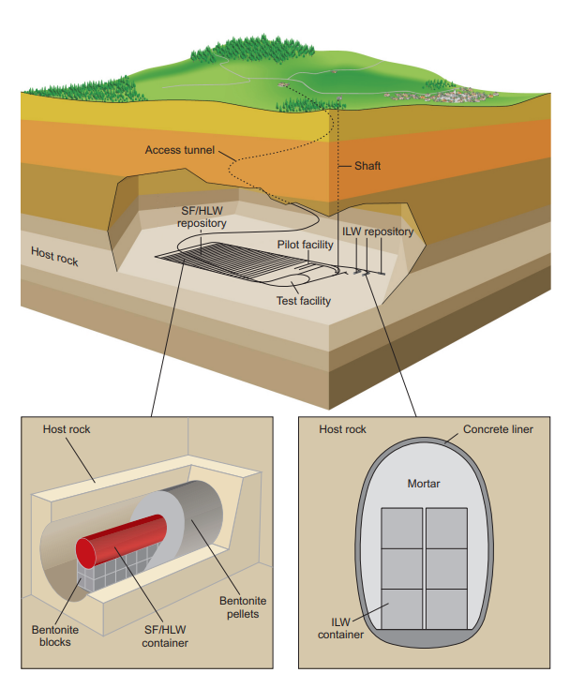Deep geological repository
Management of spent nuclear fuel and other long-lived radioactive waste
Certain work on the deep geological repository project has already been carried out in Lithuania for more than 20 years, but it has been performed by various organizations and for various purposes – mainly in scientific research, in which employees of the Institute of Physics (now – Centre of Physical and Technological Sciences (FMTC)) and the Lithuanian Energy Institute participated; or the projects financed by various organizations were developed to improve the knowledge and understanding of Lithuanian specialists working in nuclear power and related fields about the long-lived radioactive waste management.
On 3 February 2021, the Government of the Republic of Lithuania approved “Development Program for Decommissioning of Nuclear Power Facilities and Radioactive Waste Management for 2021–2030”, which outlines strategic guidelines for the management of radioactive waste. The aim of this program is to ensure that the waste is safely managed after the decommissioning of the Ignalina NPP. Spent nuclear fuel, together with long-lived radioactive waste, is expected to be disposed of in a deep geological repository.
After approval of Radioactive Waste Management Development Program, the Ministry of Energy have assigned the Radioactive Waste Management Agency (hereinafter referred to as RATA) to organise the work related to the deep geological repository project. In 2019, after the reorganization of RATA and its incorporating into INPP, the implementation of the deep geological repository project will be implemented by INPP.
The main objectives of the deep geological repository project:
- On the basis of Radioactive Waste Management Development Program, it is necessary to manage all radioactive waste that currently exists in Lithuania and that will be generated in the future as well as spent nuclear fuel.
- Long-term safety of spent nuclear fuel and long-lived radioactive waste should be ensured.
Long-lived radioactive waste to be placed into the deep geological repository:
- Spent nuclear fuel;
- Metal structures of reactors, parts of fuel assemblies and control rods;
- Graphite used in the reactor;
- Used ionizing radiation sources (Class F waste);
- Other radioactive waste related to Classes D and E waste according to BSR-3.1.2-2017 “Pre-disposal Management of Radioactive Waste at the Nuclear Facilities".
Spent nuclear fuel is the most hazardous waste. Even 99% of the total amount of radionuclides formed in the nuclear reactor remains in the spent nuclear fuel. Most of the radionuclides in the spent nuclear fuel emit alpha particles and have a long half-life, so it will take several hundred thousand years for spent nuclear fuel to become non-hazardous.
Long-lived radioactive waste means waste containing radionuclides with a half-life of more than 30 years (235U, 238U, 226Ra, 239Pu, 63Ni, 14C, 36Cl, 129I, etc.).
What is the safest way to finally dispose the spent nuclear fuel and other long-lived radioactive waste?
At present, the final disposal of radioactive waste into deep geological repositories is the only sustainable and safest, as well as technically possible way using the current means, that allows to isolate high level radioactive waste from people and the biosphere for a sufficiently long period. High level radioactive waste, disposed in the deep geological repository, will be much less damaged than in permanently observed temporary aboveground facilities. The increased threat of global terrorism is an additional factor in accelerating the search for safe solutions. Not only the spent nuclear fuel, but also highly radioactive waste from spent nuclear fuel processing, long-lived intermediate-level waste, depleted uranium, and plutonium, radium waste, etc., should be disposed in deep geological repositories.
Which locations are the most suitable for the construction of the deep geological repository?
Stable, sufficiently deep geological formations are suitable for the construction of the deep geological repository. The geological environment should act as a natural barrier, so the host rocks should be characterized by high tectonical and seismical stability and groundwater flow at the repository environment must be as low as possible. This is necessary in order to prevent transfer of radionuclides into the environment, because water is the main factor influencing the migration of radionuclides into geological environment in case of radioactive waste matrix collapse. Foreign programmes of deep geological repositories present the analysis of different geological formations: hard crystalline rocks (e.g. granite), sedimentary rocks (clays, shales, and volcanic tuff) and evaporites (rock salt). There are several suitable geological formations in Lithuania selected: crystalline rocks, various clays.
The concept of the deep geological repository constructed in clay soils applied to the deep geological repository project in Switzerland is shown below.

The concept of the deep geological repository in clay soils (The Nagra Research, Development and Demonstration (RD&D) Plan for the Disposal of Radioactive Waste in Switzerland. NAGRA Technical Report NTB-09-06. Wettingen: NAGRA, 2009, 123 p.) (HLRAW/SNF - high level radioactive waste/spent nuclear fuel; ILW-LL - long-lived intermediate level waste; RAW - radioactive waste).
Concepts can be similar, but during the implementation of each project the different challenges are occurred which have to be resolved by the project implementation team. Projects of such volume require the strong government support. Particularly important is the continuity of the regulatory legal system, non-interrupted funding and knowledge transfer, political support and many other factors.
How is managed the spent nuclear fuel in Lithuania?
Currently, the spent nuclear fuel is stored at the territory of Ignalina NPP, and since 2023 all spent nuclear fuel will be stored in “dry” type storage facilities, in special containers. The interim storage of radioactive waste in such containers is safe for 50 years. During this period must be decided how long-lived radioactive waste will be managed. As defined by Radioactive Waste Management Development Program approved on 23.12.2015 by the Resolution No. 1427 of the Government of the Republic of Lithuania, the spent nuclear fuel in Lithuania as well as long-lived radioactive waste should be disposed into the deep geological repository.
When the first deep geological repository in Lithuania will be built?
Work related to the design of the deep geological repository in Lithuania has been carried out for about 20 years. Planning works are currently in progress. Other main stages in the design of the deep geological repository:
- Site selection for the research borehole (2020-2024);
- Geological investigations in the boreholes (2025-2030);
- Site selection for the underground research laboratory and the potential sites for deep geological repository (2031-2037);
- Research in the underground laboratory, deep geological repository site confirmation (2038-2047);
- Design of the deep geological repository (2048-2057);
- Construction and commissioning of the deep geological repository (2058-2067);
- Operation of the deep geological repository (2068-2074);
- Decommissioning of the deep geological repository (2075-2079)
- Post-closure of the deep geological repository (from 2080).
During the above listed stages of the implementation of the deep geological repository project, the issues of treatment of long-lived radioactive waste and the formation of the final disposal packages will also have to be solved. The final disposal packages are the integral part of the system of barriers to radionuclide retention, so their selection will depend significantly on the characteristics of the site, the chosen concept, etc.

